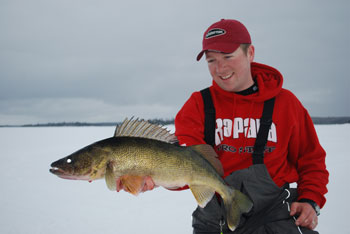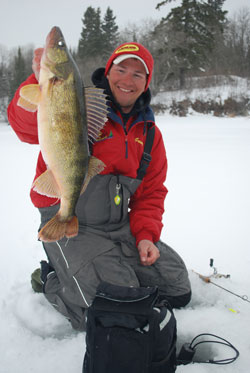After a short but enjoyable break offered by the completion of this year’s openwater fishing, excitement levels have been restored for the start of the hardwater season with the first ice bite being just around the corner.

The author landed this early season walleye using a deadstick setupFirst ice can offer some of the most spectacular angling opportunities of the ice fishing season for a variety of species, but walleye in particular seem to be particularly cooperative. I caught up with my pal Jeff Gustafson (www.gussyoutdoors.com) of Kenora, Ontario to compare notes on some of our favorite methods and locations for catching first ice walleye. Jeff is unquestionably one of the most dedicated, hardcore ice anglers out there and has earned a reputation as being amongst the best of the best when it comes to fishing throughout Ontario and the upper Midwest. Gustafson has acquired a wealth of knowledge on fishing and fish behaviors from spending countless hours in a boat and on the ice.
Location
Identifying high-potential locations should be your first consideration when going out after first ice walleye. Classic shield-type lakes can present a bit of a challenge for walleye anglers because of the abundance of great looking structure including islands, points and reefs. Gustafson and I share similar views on some of these high-potential honey holes that seem to attract walleye in the earlier stages of the ice fishing season. “The first places I look at first ice are near the last places I caught walleyes in the fall”, notes Gustafson. Gustafson looks towards areas such as mid-lake reefs or large flats in the main lake as good starting points. “Usually there are more fish on these spots once the lakes are ice covered. Cold water has the tendency to congregate many fish species resulting in larger and tighter schools”, says Gustafson.
Setting up on larger, more pronounced points with variations in depths is another solid bet for first ice walleye. Drill holes using a zigzag pattern starting from shallower water out to deeper water and hop from hole to hole until you find out what depths the fish are using. Shallower holes will often be the best producers while fishing earlier in the morning or at dusk while deeper holes are usually most consistent throughout the middle of the day.
When chasing walleye on shallower, more fertile lakes, a solid bet is to search out weed beds and set up shop in pockets or edges of the vegetation. Weed beds adjacent to a drop-off or some type of transition in bottom composition will generally out produce featureless areas.
The biggest thing to keep in mind when targeting walleye at first ice is to keep moving until you find the fish. Gustafson agrees, “I’m not a spot sitter! I like to drill, drill, and drill until I find fish. One theory I live by for nearly all species of fish is to keep moving until you find active fish”. Like many other highly successful anglers, Gustafson relies on his electronics to locate fish and determine their activity levels. “Our electronics are so good nowadays whether you are on the ice or in the boat that you can see if fish are below you before you even drop a line. Further to that, if you can see them and can’t catch them, keep moving”, says Gustafson.

When heading out after walleye, anglers should be prepared to incorporate a combination of artificial and livebait presentations to put fish on the ice. Gustafson rigs up a couple of rods that he’ll use all season long when fishing his home waters of Lake of the Woods. The first rod consists of a vertical presentation and the second a horizontal presentation. “One thing I’ve noticed is that walleye usually show a preference from day to day between the vertical presentations and horizontal presentations”, notes Gustafson. Gustafson’s go-to option for a vertical presentation is a jigging spoon with his favorite being the Northland Buckshot Rattle Spoon. I’ve had the chance to watch Gustafson nail one walleye after another using the Buckshot Spoon and it opened my eyes to the effectiveness of this spoon for catching walleye through the ice.
Although the jigging spoon catches fish right out of the package, Gustafson generally adds some extra appeal to the spoon by tipping it with a salted shiner head or minnow head. On days when vertical presentations aren’t the flavor of the day, Gustafson breaks out the Jigging Rap or Jigging Shad Rap to entice walleye. Ice electronics such as Vexilar flashers help take the guesswork out of what types of baits or presentation the fish prefer on any given day. Anglers can simply watch the flasher screen and interpret how the fish responds to the presentation and adjust from there. If fish approach the bait with speed and then swim away without striking, consider adjusting from a vertical presentation to a horizontal presentation or even switching up the size, color or jigging cadence of your offering.
A bonus to ice fishing is that in most jurisdictions anglers are able to legally fish with a second line. I’ll always take advantage of using my second line when walleye fishing and set up a ‘deadstick rod’. A ‘deadstick rod’ dangling a 4-6 inch sucker set in a rod holder or on top of a pail is tough to beat. This setup should consist of a 32 to 40 inch long rod with a really light tip that slowly tapers into some backbone towards the butt of the rod. Spool up with 8 to 10 pound test monofilament and be sure to loosen the drag of the reel when the rod is in the holder. Upon detecting a bite, open the bail of the reel to feed the fish some line and then tighten the drag just before setting the hook. Rig the sucker with a super-sharp number 6 Gamakatsu treble hook near the dorsal fin and add just enough splitshot to get the sucker down and keep it somewhat controlled. The splitshot should be placed about 8 inches above the hook. The premise behind fishing a deadstick setup is to allow the fish to inhale the bait without detecting the rod. The soft tip also acts as a great visual strike indicator.
First Ice Safety
As hot as the bite can be at first ice, make sure to take extra safety precautions when heading out on the water. Most agencies that study ice recommend a minimum of 4 inches of clear, blue ice for foot travel and at least 5 inches of clear, blue ice for ATV or snowmobile travel. Here are a few recommendations on how to stay safe:
· Never fish by yourself
· Wear some type of flotation device (Inflatable PFD, Floater Coat, etc.)
· Wear extraction devices such as Normark Ice Picks
· Spread out when travelling on the ice
· Bring a throw rope
· Test the ice in a variety of locations
· Avoid areas with current, rotting vegetation or springs
Some of the hottest ice fishing action is just around the corner so now is the time to get your gear prepped and be ready to head out after first ice walleye. Keep some of these tips in mind and most importantly be safe this winter!










